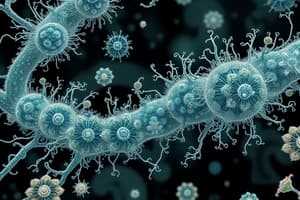Podcast
Questions and Answers
Which type of microorganism is acellular and requires a host to replicate?
Which type of microorganism is acellular and requires a host to replicate?
- Protozoa
- Viruses (correct)
- Bacteria
- Fungi
What process allows organisms with favorable traits to reproduce more successfully?
What process allows organisms with favorable traits to reproduce more successfully?
- Gene Flow
- Genetic Drift
- Natural Selection (correct)
- Speciation
Which of the following is a characteristic of anaerobic bacteria?
Which of the following is a characteristic of anaerobic bacteria?
- They require oxygen to survive.
- They are exclusively multicellular.
- They are commonly found in the gut. (correct)
- They can be pathogenic or beneficial.
Which of the following is NOT a method of evidence supporting evolution?
Which of the following is NOT a method of evidence supporting evolution?
What type of speciation occurs without geographic separation?
What type of speciation occurs without geographic separation?
Which metabolic process do most bacteria utilize?
Which metabolic process do most bacteria utilize?
Which of the following best describes genetic drift?
Which of the following best describes genetic drift?
Which statement best represents the Modern Synthesis in evolutionary biology?
Which statement best represents the Modern Synthesis in evolutionary biology?
Flashcards are hidden until you start studying
Study Notes
Microbiology
- Definition: Study of microorganisms, including bacteria, viruses, fungi, and protozoa.
- Types of Microorganisms:
- Bacteria: Prokaryotic, unicellular organisms; can be beneficial (e.g., gut flora) or pathogenic.
- Viruses: Acellular entities that require a host to replicate; cause diseases (e.g., influenza, HIV).
- Fungi: Eukaryotic, can be unicellular (yeasts) or multicellular (molds); important for decomposition and medicine (e.g., penicillin).
- Protozoa: Unicellular eukaryotes; can be free-living or parasitic (e.g., malaria).
- Microbial Metabolism:
- Aerobic: Requires oxygen (e.g., most bacteria).
- Anaerobic: Does not require oxygen (e.g., some bacteria in gut).
- Applications:
- Medicine: Antibiotics from fungi and bacteria.
- Biotechnology: Genetic engineering, fermentation processes.
- Environmental Science: Bioremediation using microbes to clean up pollutants.
Evolution
- Definition: Change in the heritable characteristics of biological populations over successive generations.
- Key Concepts:
- Natural Selection: The process where organisms with favorable traits are more likely to reproduce (survival of the fittest).
- Genetic Drift: Random changes in allele frequencies in a population, significant in small populations.
- Gene Flow: Transfer of genetic material between populations, which can increase genetic diversity.
- Evidence for Evolution:
- Fossil Record: Shows changes in species over time and transitional forms.
- Comparative Anatomy: Homologous structures indicate common ancestry (e.g., forelimbs of mammals).
- Molecular Biology: DNA and protein similarities among different species suggest evolutionary relationships.
- Speciation:
- Allopatric Speciation: Occurs when populations are geographically isolated.
- Sympatric Speciation: Occurs without geographic separation, often through polyploidy in plants.
- Evolutionary Theories:
- Darwin's Theory: Emphasizes natural selection; "On the Origin of Species" outlines mechanisms of evolution.
- Modern Synthesis: Integrates genetics with Darwinian evolution, explaining how evolutionary processes can occur at the genetic level.
Microbiology
- Microbiology encompasses the study of microorganisms, including bacteria, viruses, fungi, and protozoa.
- Bacteria are prokaryotic and unicellular; some play beneficial roles while others are pathogenic.
- Viruses are acellular and require a host to replicate; they are responsible for diseases such as influenza and HIV.
- Fungi are eukaryotic, existing as unicellular (yeasts) or multicellular (molds); they are essential for decomposition and for producing antibiotics like penicillin.
- Protozoa are unicellular eukaryotes that can exist independently or as parasites, such as the organisms causing malaria.
- Microbial Metabolism includes:
- Aerobic processes that require oxygen, prevalent in most bacteria.
- Anaerobic processes that do not require oxygen, utilized by specific gut bacteria.
- Applications of microbiology span across various fields:
- In medicine, antibiotics derived from fungi and bacteria are crucial for treating infections.
- Biotechnology utilizes microorganisms in genetic engineering and fermentation processes.
- In environmental science, microbes are employed in bioremediation efforts to detoxify polluted environments.
Evolution
- Evolution refers to the change in heritable characteristics of biological populations across generations.
- Natural Selection is a key mechanism, where organisms with advantageous traits have higher reproductive success, often summarized as "survival of the fittest."
- Genetic Drift involves random fluctuations in allele frequencies, particularly significant in smaller populations.
- Gene Flow describes the movement of genetic material between populations, contributing to increased genetic diversity in a species.
- Evidence for Evolution includes:
- The fossil record which documents species changes over time and shows transitional forms.
- Comparative anatomy, where homologous structures across different species indicate a common ancestry (e.g., similar forelimbs in mammals).
- Molecular biology, revealing DNA and protein similarities across species that imply evolutionary connections.
- Speciation can occur through:
- Allopatric speciation, where geographic isolation leads to population divergence.
- Sympatric speciation, which can happen without geographical barriers, often due to polyploidy in plants.
- Evolutionary theories are foundational:
- Darwin's Theory focuses on natural selection as a driving force in evolution, articulated in "On the Origin of Species."
- The Modern Synthesis merges genetics with natural selection, explaining how evolutionary mechanisms operate at the genetic level.
Studying That Suits You
Use AI to generate personalized quizzes and flashcards to suit your learning preferences.




